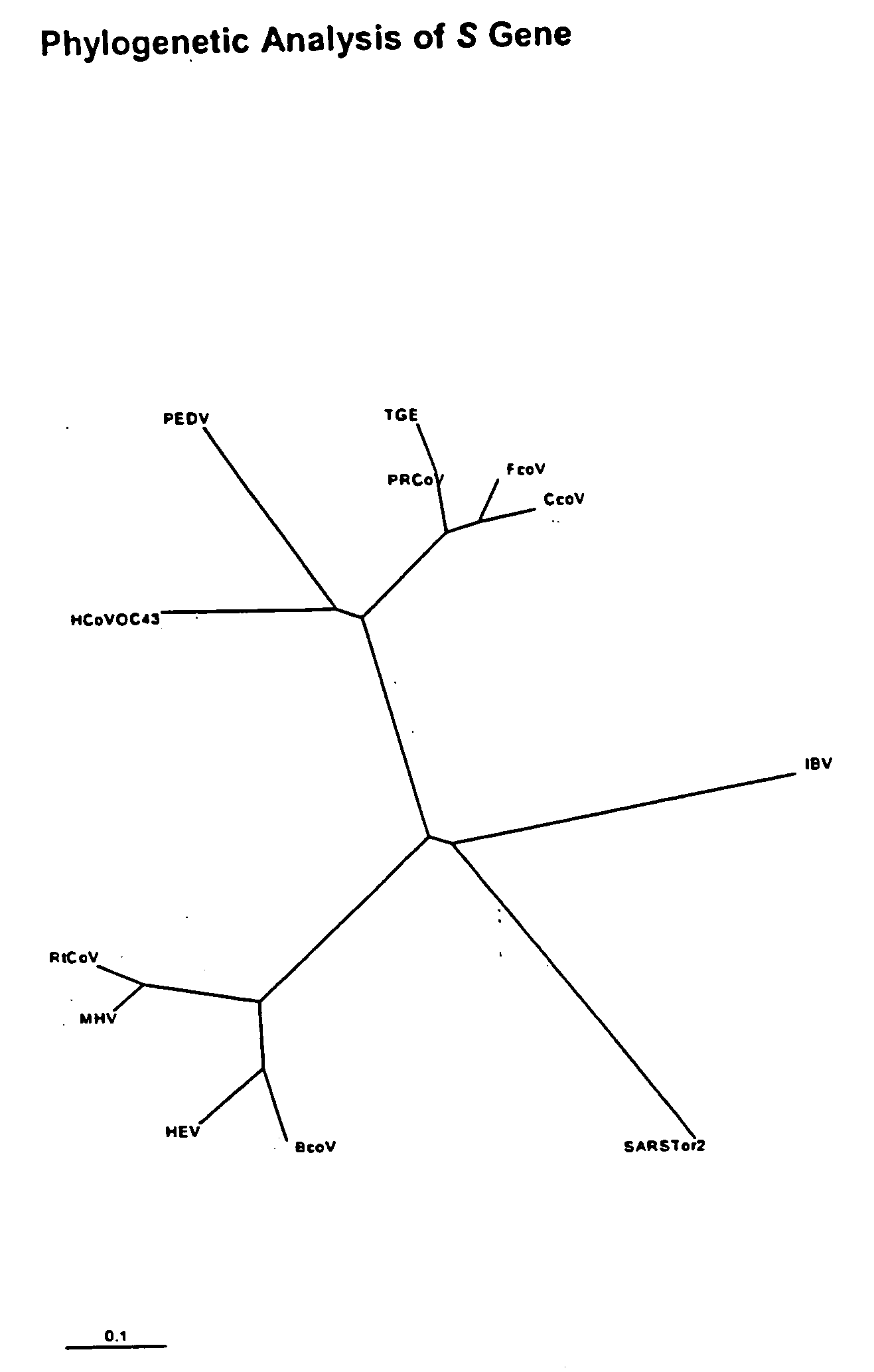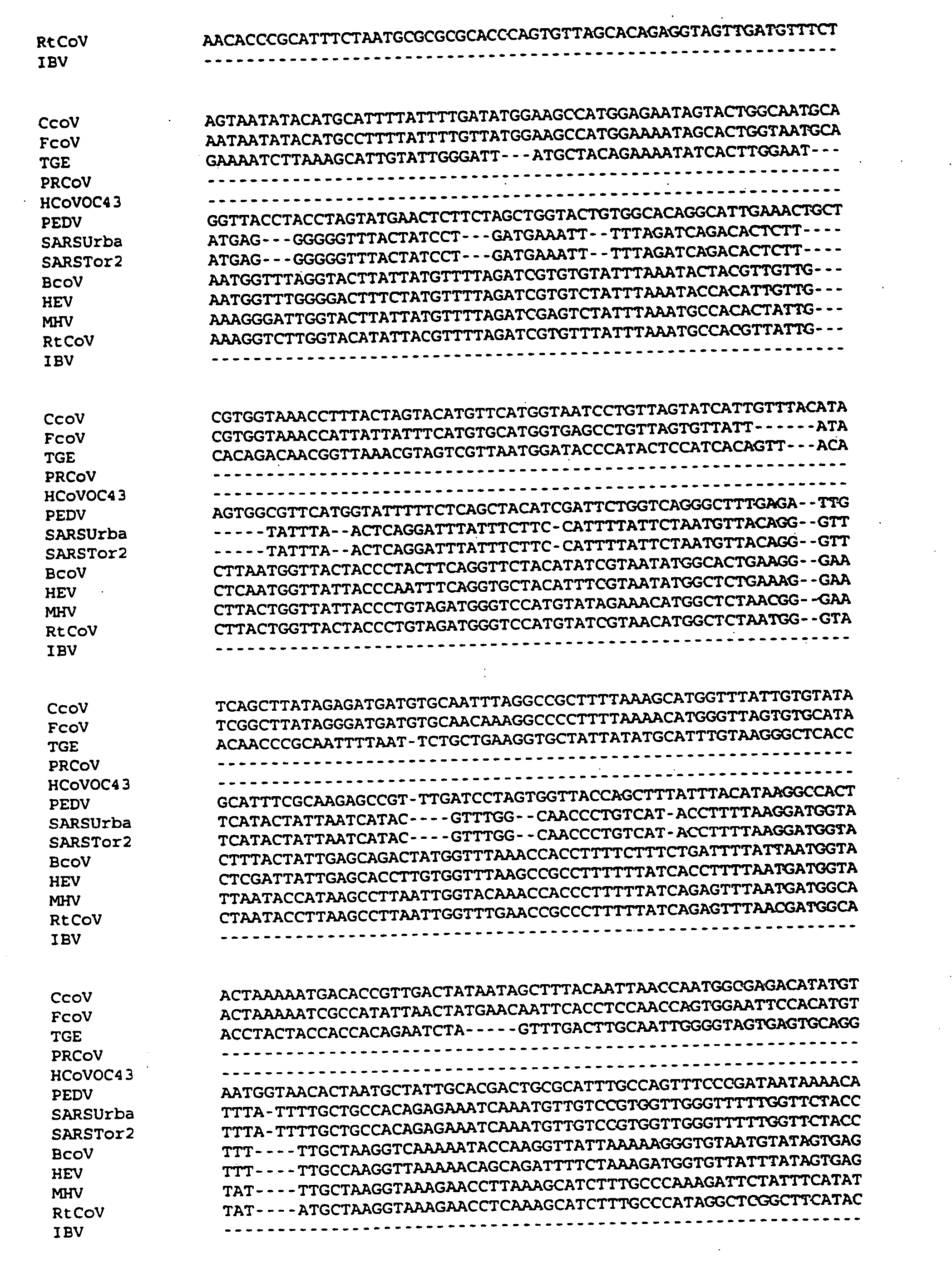Multi-allelic molecular detection of SARS-associated coronavirus
a coronavirus and molecular detection technology, applied in the field of multiallelic molecular detection of sars-associated coronavirus, can solve the problems of failure to consider, failure to account for the possibility of continuous and/or multiple introduction of non-genetically identical sars-cov strains into the human population, and deletion of part of an important gene, so as to enhance the likelihood of fundamental genetic drift of the virus, minimize the likelihood, and enhance the intrinsic sensitivity of the assay
- Summary
- Abstract
- Description
- Claims
- Application Information
AI Technical Summary
Benefits of technology
Problems solved by technology
Method used
Image
Examples
example 1
Design of SARS-CoV-Specific Molecular Beacons and Primers for Reverse Transcription and for PCR
[0051] Purpose: The overall rationale in the design of molecular beacons and oligonuclotides for our SARS assay is to construct mismatch-tolerant molecular beacons that are thermodynamically compatible to work in a five-amplicon multiplex assay.
[0052] Design: The molecular beacons were designed so that they are able to hybridize to their targets at the annealing temperature of the PCR, while unbound molecular beacons remain in the closed conformation. These basic aspects were achieved by using coronavirus gene-specific multiple alignments and thermodynamic considerations to select the target sequences, the identity and length of the PCR primers, the identity and length of the probe sequences (target recognition sequences), and the length of the arm sequences.
[0053] Materials: In order to theoretically calculate the melting temperatures of the PCR primers and the probe-target hybrids, wa...
example 2
Experimental Characterization of the Molecular Beacons and the Molecular Beacon-Target Complexes
[0057] Purpose: The overall rationale of these experiments is to evaluate the thermodynamic properties of the constructed molecular beacons prior to carrying out real-time PCR experiments.
[0058] Design: For each molecular beacon, we have determined two melting curves—one for beacon alone, and one for the beacon-target complex—by using the ABI Prism 7700 spectrofluorometric thermal cycler.
[0059] Materials: For each molecular beacon, melting curves were obtained by preparing two tubes containing 50 μL of 200 nM molecular beacon dissolved in 3.5 mM MgCl2 and 10 mM Tris-HCl, pH 8.0, and by adding a complementary oligonucleotide target to one of the tubes at a final concentration of 400 nM.
[0060] The fluorescence of each solution was determined as a function of temperature, using a thermal cycler with the capacity to monitor fluorescence. Temperature was decreased linearly with time from 8...
example 3
Uniplex SARS-CoV Viral and IPC PCR Amplifications Using SYBR Green to Detect the Amplicaons
[0064] Purpose: The overall rationale of these experiments is to evaluate the PCR primers and PCR conditions.
[0065] Design: For each SARS-CoV gene-specific and IPC amplification, a synthetic target DNA was used. PCR reactions were performed using a spectrofluorometric thermal cycler (Cepheid).
[0066] Materials: The PCR protocols are shown in the following exhibits:
[0067] for S Gene:
[0068] (A) SYBR Green-Based Detection of S Gene Amplicon (LK250) of SARS-Associated CoV
MixturePer reactiondH20 15 μl10X PCR Buffer (10X)2.5 μlMgCl2 (25 mM)4.0 μlPlat Taq DNA Pol (5 Uμl−1)0.3 μldNTP (25 mM)0.3 μlLK251 (10 pmole / μl)0.5 μlLK252 (10 pmole / μl)0.5 μlSybr Green DNA (25X)1.0 μlTarget DNA1.0 μlTOTAL25.0 μl
[0069] Smart Cycler (Cepheid)
DNA Denaturation & Enzyme ActivationCycles: 1Target Temperature (° C.):95120 sec
[0070]
Primary AmplificationCycles: 35Denaturation:95° C.15 secAnnealing:53° C.15 secSpec...
PUM
| Property | Measurement | Unit |
|---|---|---|
| Composition | aaaaa | aaaaa |
| Fluorescence | aaaaa | aaaaa |
Abstract
Description
Claims
Application Information
 Login to View More
Login to View More - R&D
- Intellectual Property
- Life Sciences
- Materials
- Tech Scout
- Unparalleled Data Quality
- Higher Quality Content
- 60% Fewer Hallucinations
Browse by: Latest US Patents, China's latest patents, Technical Efficacy Thesaurus, Application Domain, Technology Topic, Popular Technical Reports.
© 2025 PatSnap. All rights reserved.Legal|Privacy policy|Modern Slavery Act Transparency Statement|Sitemap|About US| Contact US: help@patsnap.com



